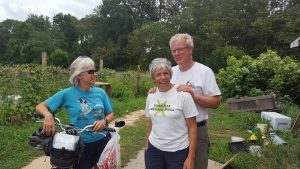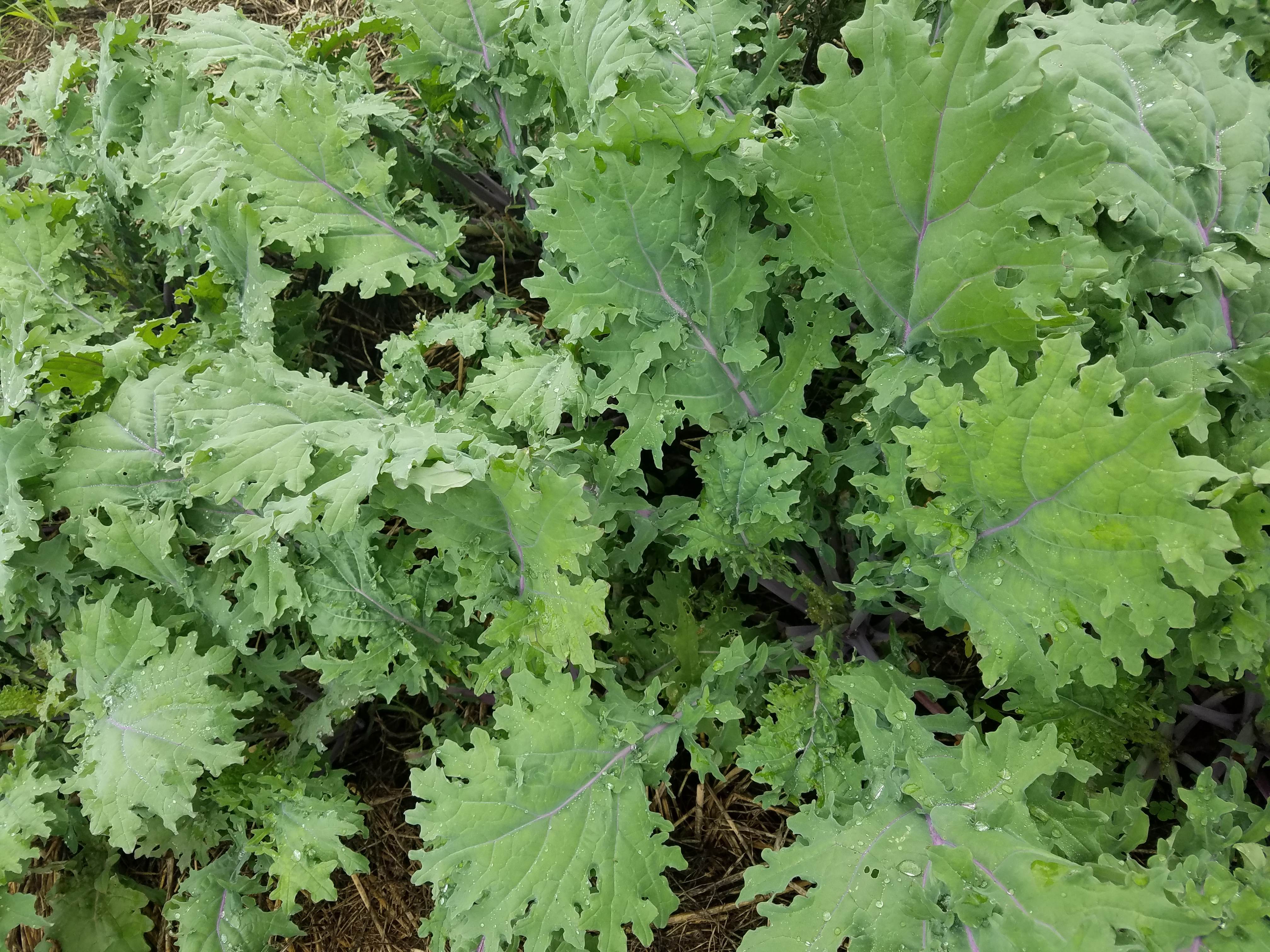While the market for organic products has never been larger, there are worries in the organic community. Right now there is some terrible fighting going on between the old guard of organic producers and the larger, corporate, organic providers who are increasingly in charge as the USDA has become more tightly aligned with large agribusinesses.
While there are still many fine certified organic farms, many small farms are no longer getting certified. There is a growing plethora of other certifications as folks try to differentiate themselves. Certified Naturally Grown, Certified Biodynamic, Certified Humanely Raised, and a host of others now adorn farmers stands and products on the shelf. It is rather confusing and sad for us . “Organic” used to be a short cut to know that the product was relatively free of bad stuff like pesticides and higher in good values like sustainable soil practices or ecological diversity. The organic program was always risky since the federal regulatory system is so vulnerable to corporate lobbying. Sadly, the program has slowly been weakened. The organic certification has now been so compromised that over half of the vegetables labeled organic are from overseas, most from industrially scaled farms, and more and more of the organic meats and eggs are coming from certified organic, industrially sized CAFO’s (Concentrated Animal Feeding Operations).
There are real questions for us on what “organic” can mean in this context. Clearly soil health and biodiversity are barely connected to the certification anymore. Hydroponic vegetables are now certified even though they are grown in a nutrient broth derived from conventional soybean production. Where is the healthy soil component of that? The list of “approved” materials for organic production now includes some pretty potent pesticides and herbicides. I bought some fertilizer for my pasture that was “organic approved” and was disappointed to find out that it came from regular chicken production and only became “organic” once it was processed and turned into pellets at a Perdue factory. It takes three years of organic production before soil is considered organic but apparently chicken manure from a CAFO is magically organic after a few weeks of composting, and right after it is ground up, wetted, and dried into extruded pellets.
Now that large industrial enterprises are making organic products according to these new cheaper standards, the price of organics is dropping. On one hand, those lower prices broaden the market and more and more consumers are substituting organic products for conventional products. But there are questions about what the consumer really gets from this new industrial “organic” production. What happens when the “good” organic producers cannot survive these new lower prices. Labor costs are rising in a much tighter labor market. Land prices near viable markets are generally rising too. The actual cost of producing good food is still going up not down and many small organic farms are going out of business.
I read an article this morning from a farmer who is facing collapsing organic milk pricing as the organic CAFO’s are coming on line for Walmart and Costco and others so they can sell organically certified milk at much lower prices. He explained that there is a requirement that organic milk come from cows that are pasture raised with minimal requirements that a certain percentage of their food come from roughage (grasses and hay) rather than corn/soybean/wheat industrial foods. Milk on pasture has a number of health benefits not found in industrially raised milk. Fundamentally, healthy cows produce healthier milk. Cows on pasture are eating the foods that their stomachs were designed to efficiently turn into nutrition. Not surprisingly, they are healthier and happier cows. That was the promise of “organic” milk. But as this farmer pointed out, these new enterprises cannot be raising pasture raised “organic” milk. You simply cannot have 15,000 cows and move them from a milking station to pasture each day. As he pointed out, cows just do not move very quickly. To get them to a viable fresh pasture each day on that scale would require thousands of acres and it would take way too long to move them across those distances and then back again to be milked. But there are many 15,000 “organic” herds of milk cows supplying “organic” milk to our food supply chain. As a result, there is now an oversupply of “organic” milk, prices are dropping, and organic dairy farmers around the country are going out of business. Most sadly, farming has now become the profession with the highest suicide rate, over twice the rate of veterans. Small farmers are clearly losing hope.
With the organic label meaning less and less, how can you find good and nutritious food if you cannot use that label to help you anymore? Where can you turn to find good food you can trust? This is a frustratingly hard question. Who has the time to spend on researching their food sources?
This is the reality – if you care about good food that is raised to be nutritious and not just low cost, you have to buy from a local farmer you trust. There is no other way. And even then, you have to watch that farmer that they are not seduced by industrial methods that lower costs and nutrition. It is much easier to raise cheap food than good food. It is not easy to grow truly healthy food. This is the core of why we do what we do at our farm. It is what we have always strived to provide our customers. It is also why we work to convince more folks to try farming or at least have their own garden. It is why we love having young folks working on our farm who then leave to “spread the word”. We are convinced that agriculture needs a major reset to move it back to a realm that is more sustainable and healthier. We hope our farm makes a small contribution in this community to move food production in a better direction, towards healthier, more nutritious, and tastier vegetables. And we hope that you realize when you buy from us that you are truly supporting that effort.
Thank you.
Cricket.




 Thank you, thank you for being our reciprocal for that, and for all the wonderful volunteers who came through for us on our most bleak days. Our customer appreciation dinner in October was a great success! So much good, local food, shared among friends. My mouth is already watering for the next one!
Thank you, thank you for being our reciprocal for that, and for all the wonderful volunteers who came through for us on our most bleak days. Our customer appreciation dinner in October was a great success! So much good, local food, shared among friends. My mouth is already watering for the next one! Christmas. I for one enjoyed getting to know the woods a bit better while I scouted for the greenest boxwood and the most delectable holly. We hope you enjoyed the premier, and we felt it was rather a booming success. We hope that wreath production will become a staple of our business and hope we can adorn your doors in the coming winter.
Christmas. I for one enjoyed getting to know the woods a bit better while I scouted for the greenest boxwood and the most delectable holly. We hope you enjoyed the premier, and we felt it was rather a booming success. We hope that wreath production will become a staple of our business and hope we can adorn your doors in the coming winter.
 The last item I have to discuss is the erection of our hoop house. We did not foresee this unusually cold weather, and thus I went a little crazy in the greenhouse. We like to get a head-start with our spring crops by starting them early in the greenhouse and moving them into the field as soon as possible under row-cover. I made the crop plan this year, and call me ambitious, but it became abundantly clear that we had out-grown the
The last item I have to discuss is the erection of our hoop house. We did not foresee this unusually cold weather, and thus I went a little crazy in the greenhouse. We like to get a head-start with our spring crops by starting them early in the greenhouse and moving them into the field as soon as possible under row-cover. I made the crop plan this year, and call me ambitious, but it became abundantly clear that we had out-grown the  greenhouse attached to the barn (there are seeds growing out of every visible vertical and horizontal space, not to mention sprouting in plastic baggies. I’m pretty sure they will start climbing up the walls soon and you might find me at the bottom of a tangle of roots). Arthur and Carol had apparently seen this coming, and had plans in the works for building a hoop-house. We got the big steel hoops from a neighbor and loyal member, ordered some plastic, Cricket worked his magic in the wood-workshop, and voila! A hoop house! It is unheated, but has big doors on each end, to help with air-flow and temperature regulation. The idea is to move the sprouts out of the greenhouse at the first sign of true leaves, and into the hoop-house, where they will get used to the outside temperatures, and harden themselves before we plant them into the warm ground. This will allow us to grow more intensively in our cultivated area, only about 2 acres of which we use to produce for all of you! This is very exciting and I hope we can all reap the benefits in the coming season. Hopefully this will help us more fluidly move crops along from one season to the next.
greenhouse attached to the barn (there are seeds growing out of every visible vertical and horizontal space, not to mention sprouting in plastic baggies. I’m pretty sure they will start climbing up the walls soon and you might find me at the bottom of a tangle of roots). Arthur and Carol had apparently seen this coming, and had plans in the works for building a hoop-house. We got the big steel hoops from a neighbor and loyal member, ordered some plastic, Cricket worked his magic in the wood-workshop, and voila! A hoop house! It is unheated, but has big doors on each end, to help with air-flow and temperature regulation. The idea is to move the sprouts out of the greenhouse at the first sign of true leaves, and into the hoop-house, where they will get used to the outside temperatures, and harden themselves before we plant them into the warm ground. This will allow us to grow more intensively in our cultivated area, only about 2 acres of which we use to produce for all of you! This is very exciting and I hope we can all reap the benefits in the coming season. Hopefully this will help us more fluidly move crops along from one season to the next.

 People often ask me why I farm. Or perhaps more directly, why would I work in a profession that generates little respect because it almost never creates monetary wealth for its practitioners. It is not a trivial question. Carol and I spend a lot of time justifying our lifestyle to each other. The funny thing is, everyone who asks us this seems to have some sense that we are doing something incredibly positive. People thank us all the time for doing what we do. They regale us with stories about great meals, great times, and great memories connected with our humble vegetables. And usually, they express at least some desire to join us- “I would love to do what you do someday”. Right now, our farm works partly because we get so much “free” help from others. We have two wonderful women who are currently working on the farm one morning a week together. Ostensibly they are doing it to learn our techniques to apply to their own gardens. But I think they are enjoying getting their hands dirty“farming”. It helps to balance out some of the rest of life that is so disconnected today to our natural world. There seems to be something positive for the human spirit working at a diversified farm. The image is so powerful it is used everywhere in food marketing – ad campaigns often start with a beautiful morning sunrise, a rooster crowing in the background, and misty fields and woods with grass fed cows or sheep, and nature in abundance all around. What is fascinating for me is that most of the time, the products being sold are a long way from the reality of that beautiful farm. Most farming operations are not pleasant to see or visit. “Modern” farms are industrial operations scaled up to a mind boggling size. They do not feed the soul the way a smaller diversified farm seems to. A big part of why we farm is because it feels right. It is beautiful. It is great exercise. But more than these, it is healthful to live life simply in nature’s seasonal rhythm. It is spring now and we are planting seeds and nurturing baby plants. In a few weeks, we will start to plant outside and begin building for the first harvests in April or May. Our activities mirror Nature with her gradually building crescendo of birds, insects, frogs, and plant life waking up after the winter quiet. It is a wonderful pattern that is central to our motivation to work on our small farm.
People often ask me why I farm. Or perhaps more directly, why would I work in a profession that generates little respect because it almost never creates monetary wealth for its practitioners. It is not a trivial question. Carol and I spend a lot of time justifying our lifestyle to each other. The funny thing is, everyone who asks us this seems to have some sense that we are doing something incredibly positive. People thank us all the time for doing what we do. They regale us with stories about great meals, great times, and great memories connected with our humble vegetables. And usually, they express at least some desire to join us- “I would love to do what you do someday”. Right now, our farm works partly because we get so much “free” help from others. We have two wonderful women who are currently working on the farm one morning a week together. Ostensibly they are doing it to learn our techniques to apply to their own gardens. But I think they are enjoying getting their hands dirty“farming”. It helps to balance out some of the rest of life that is so disconnected today to our natural world. There seems to be something positive for the human spirit working at a diversified farm. The image is so powerful it is used everywhere in food marketing – ad campaigns often start with a beautiful morning sunrise, a rooster crowing in the background, and misty fields and woods with grass fed cows or sheep, and nature in abundance all around. What is fascinating for me is that most of the time, the products being sold are a long way from the reality of that beautiful farm. Most farming operations are not pleasant to see or visit. “Modern” farms are industrial operations scaled up to a mind boggling size. They do not feed the soul the way a smaller diversified farm seems to. A big part of why we farm is because it feels right. It is beautiful. It is great exercise. But more than these, it is healthful to live life simply in nature’s seasonal rhythm. It is spring now and we are planting seeds and nurturing baby plants. In a few weeks, we will start to plant outside and begin building for the first harvests in April or May. Our activities mirror Nature with her gradually building crescendo of birds, insects, frogs, and plant life waking up after the winter quiet. It is a wonderful pattern that is central to our motivation to work on our small farm.

